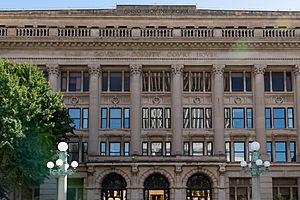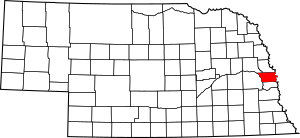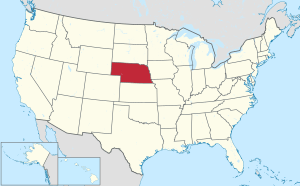Douglas County, Nebraska facts for kids
Quick facts for kids
Douglas County
|
|||
|---|---|---|---|

Douglas County Courthouse in Omaha
|
|||
|
|||

Location within the U.S. state of Nebraska
|
|||
 Nebraska's location within the U.S. |
|||
| Country | |||
| State | |||
| Founded | November 23, 1854 | ||
| Named for | Stephen A. Douglas | ||
| Seat | Omaha | ||
| Largest city | Omaha | ||
| Area | |||
| • Total | 339 sq mi (880 km2) | ||
| • Land | 328 sq mi (850 km2) | ||
| • Water | 11 sq mi (30 km2) 3.2%% | ||
| Population
(2020)
|
|||
| • Total | 584,526 | ||
| • Estimate
(2023)
|
589,540 |
||
| • Density | 1,724.3/sq mi (665.7/km2) | ||
| Time zone | UTC−6 (Central) | ||
| • Summer (DST) | UTC−5 (CDT) | ||
| Congressional district | 2nd | ||
Douglas County is a county located in the U.S. state of Nebraska. As of the 2020 United States Census, the population is 584,526. It is the state's most populous county, home to just under 30% of Nebraska's residents. Its county seat is Omaha, the state's largest city. The county was established in 1854 and named after Stephen A. Douglas (1813–1861), who was then serving as a U.S. senator from Illinois.
Douglas County is part of the Omaha-Council Bluffs, NE-IA Metropolitan Statistical Area.
In the Nebraska license plate system, Douglas County was represented by the prefix "1" (as it had the largest number of vehicles registered in the state when the license plate system was established in 1922). In 2002, the state discontinued the 1922 system in the three most populous counties: Douglas, Lancaster, and Sarpy counties.
Contents
Geography
Douglas County is on the eastern border of Nebraska. Its east boundary line abuts the west boundary line of the state of Iowa, across the Missouri River. The Elkhorn River runs southward through the west-central part of Douglas County, and it is bordered on east (Missouri River) and west (Platte River) by rivers. According to the U.S. Census Bureau, the county has a total area of 339 square miles (880 km2), of which 328 square miles (850 km2) is land and 11 square miles (28 km2) (3.2%) is water.
Major highways
 Interstate 80
Interstate 80 Interstate 480
Interstate 480 Interstate 680
Interstate 680 U.S. Highway 6
U.S. Highway 6 U.S. Highway 75
U.S. Highway 75 U.S. Highway 275
U.S. Highway 275 Nebraska Highway 31
Nebraska Highway 31 Nebraska Highway 36
Nebraska Highway 36 Nebraska Highway 50
Nebraska Highway 50 Nebraska Highway 64
Nebraska Highway 64 Nebraska Highway 85
Nebraska Highway 85 Nebraska Highway 92
Nebraska Highway 92 Nebraska Highway 133
Nebraska Highway 133
Transit
- Amtrak California Zephyr (Omaha station)
- Burlington Trailways (Omaha Bus Station)
- Express Arrow (Omaha Bus Station)
- Jefferson Lines (Omaha Bus Station)
- Metro Transit
Adjacent counties
- Dodge County – northwest
- Washington County – north
- Pottawattamie County, Iowa – east
- Sarpy County – south
- Saunders County – west
Protected areas
- Bluestem Prairie Preserve
- Two Rivers State Recreation Area
Demographics
| Historical population | |||
|---|---|---|---|
| Census | Pop. | %± | |
| 1860 | 4,328 | — | |
| 1870 | 19,982 | 361.7% | |
| 1880 | 37,645 | 88.4% | |
| 1890 | 158,008 | 319.7% | |
| 1900 | 140,590 | −11.0% | |
| 1910 | 168,546 | 19.9% | |
| 1920 | 204,524 | 21.3% | |
| 1930 | 232,982 | 13.9% | |
| 1940 | 247,562 | 6.3% | |
| 1950 | 281,020 | 13.5% | |
| 1960 | 343,490 | 22.2% | |
| 1970 | 389,455 | 13.4% | |
| 1980 | 397,038 | 1.9% | |
| 1990 | 416,444 | 4.9% | |
| 2000 | 463,585 | 11.3% | |
| 2010 | 517,110 | 11.5% | |
| 2020 | 584,526 | 13.0% | |
| 2023 (est.) | 589,540 | 14.0% | |
| US Decennial Census 1790-1960 1900-1990 1990-2000 2010-2019 |
|||
2020 census
As of the 2020 United States Census, there were 584,526 people in the county. The population density was 1,724 people per square mile (666 people/km2). The racial makeup of the county was 68.8% White, 11.5% Black or African American, 1.2% Native American, 4.3% Asian, 0.1% Pacific Islander, and 2.8% from two or more races. 12.9% of the population were Hispanic or Latino of any race.
2010 census
As of the 2010 United States Census, there were 517,110 people and 206,522 households in the county. The population density was 1,574 people per square mile (608 people/km2). There were 219,580 housing units at an average density of 669 units per square mile (258/km2). The racial makeup of the county was 76.4% White, 11.6% Black or African American, 0.7% Native American, 2.7% Asian, 0.1% Pacific Islander, 5.7% from some other race, and 2.8% from two or more races. 11.2% of the population were Hispanic or Latino of any race. 30% were of German, 15% Irish, 8.0% English, and 4.9% Italian ancestry.
The median income for a household in the county was $51,878, and the median income for a family was $67,666. Males had a median income of $44,542 versus $35,801 for females. The per capita income for the county was $28,092. About 9.4% of families and 13.1% of the population were below the poverty line, including 17.6% of those under age 18 and 8.0% of those age 65 or over.
Communities
Cities
- Bennington
- Omaha (county seat)
- Ralston
- Valley
Villages
Census-designated places
- King Lake
- Venice
Unincorporated communities
Education
School districts include:
- Arlington Public Schools
- Bennington Public Schools
- Douglas County West Community Schools
- Elkhorn Public Schools
- Fort Calhoun Community Schools
- Fremont Public Schools
- Gretna Public Schools
- Millard Public Schools
- Omaha Public Schools
- Ralston Public Schools
- Westside Community Schools
- Yutan Public Schools
A state-operated school, Nebraska School for the Deaf, was formerly in the county.
See also
 In Spanish: Condado de Douglas (Nebraska) para niños
In Spanish: Condado de Douglas (Nebraska) para niños



